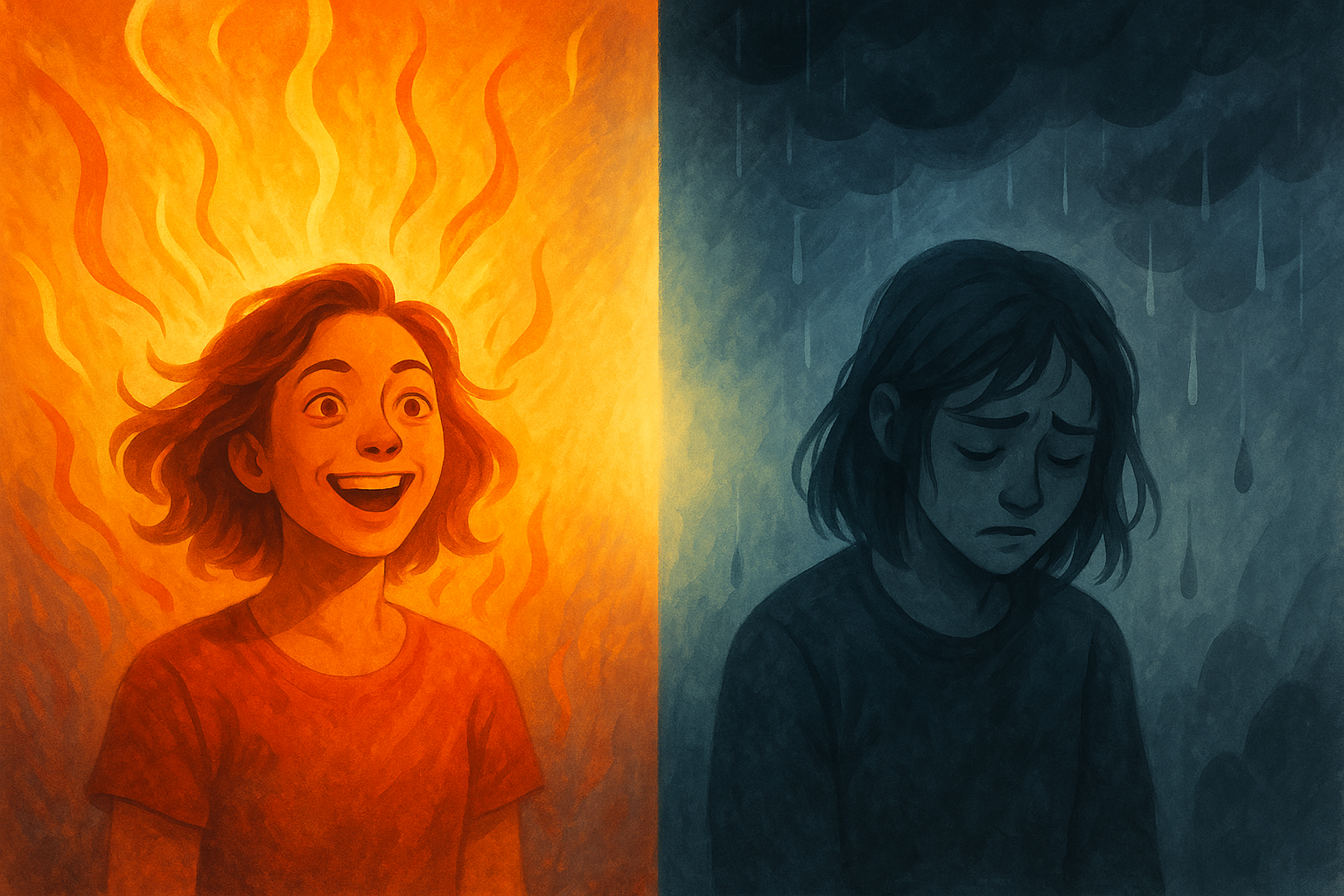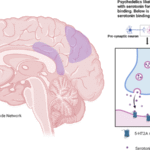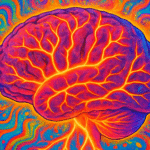Living with bipolar disorder is like riding an emotional rollercoaster where you can’t control the speed, direction, or when it will stop. One day you might feel like you can conquer the world, and the next, you can barely get out of bed. This mental health condition affects millions of people worldwide, yet it remains widely misunderstood. Let’s explore what bipolar disorder really means, how it changes the brain, and most importantly, how we can support those living with this challenging condition.
What Is Bipolar Disorder and How Is It Diagnosed?
Bipolar disorder, once called manic-depressive illness, is a brain condition that causes extreme mood swings between emotional highs (mania or hypomania) and devastating lows (depression). Think of it as your brain’s emotional thermostat being broken – instead of maintaining a steady, comfortable temperature, it swings wildly between blazing hot and freezing cold.
The Diagnosis Journey: More Complex Than You’d Think
Getting a proper diagnosis isn’t as simple as taking a blood test or getting an X-ray. In fact, it can take years for someone to receive an accurate bipolar diagnosis. Here’s why:
The Waiting Game: Doctors need to observe mood patterns over time because bipolar involves changes that happen across weeks, months, or even years. Unlike a broken bone that shows up immediately on an X-ray, mood episodes need to be tracked and documented.
The Diagnostic Process: When someone finally seeks help, mental health professionals will ask detailed questions about:
- How many symptoms they experience and which types
- How long mood episodes last
- How often episodes occur
- How symptoms impact daily life
- Family history of mental health conditions
The Tricky Part: Many people with bipolar disorder only seek help during depressive episodes because, let’s face it, when you’re feeling on top of the world during mania, you don’t typically think something’s wrong. This means the manic episodes often go unnoticed by healthcare providers initially.
Mood Tracking: Doctors often ask patients to keep detailed mood diaries, noting sleep patterns, energy levels, and daily experiences. This helps identify patterns that might not be obvious during a single appointment.
Types of Bipolar Disorder
There are several types of bipolar disorder, each with its own characteristics:
Bipolar I: This involves at least one full manic episode that lasts seven days or is severe enough to require hospitalization. Depression episodes may also occur.
Bipolar II: This features at least one major depressive episode and one hypomanic episode (less severe than full mania), but no full manic episodes.
Cyclothymia: This involves at least two years of many periods of hypomanic and depressive symptoms that are less severe than major depression.
How Bipolar Disorder Rewires Your Brain
Understanding what happens in the brain during bipolar disorder helps explain why it’s such a challenging condition to live with. Research shows that bipolar disorder literally changes the structure and function of your brain.
The Brain Regions Affected
The Prefrontal Cortex: This is your brain’s CEO – it handles decision-making, planning, and controlling impulses. In people with bipolar disorder, this area often shows decreased gray matter, which explains why decision-making becomes so difficult during episodes.
The Amygdala: Think of this as your brain’s alarm system. In bipolar disorder, the amygdala can become enlarged and hyperactive, making emotions feel more intense and threatening. It’s like having a smoke detector that goes off every time you make toast.
The Hippocampus: This brain region helps with memory and learning. Bipolar disorder can cause changes here too, which might explain why people sometimes struggle to remember things clearly during episodes.
The Gray Matter Mystery
Perhaps most concerning is what researchers call “gray matter loss”. Gray matter is essentially your brain’s processing power – it’s packed with neurons that do the actual thinking. Studies involving over 1,800 people with bipolar disorder found decreased gray matter thickness in several brain regions.
But here’s the important part: early treatment might help prevent some of this damage. It’s like catching rust on a car early – the sooner you address it, the better you can protect what’s underneath.
What This Means in Real Life
These brain changes aren’t just numbers on a medical chart – they translate into real, daily challenges:
During Manic Episodes: The overactive brain regions might explain why thoughts race so fast it’s hard to keep up, why sleep seems unnecessary, and why risky decisions feel perfectly reasonable.
During Depressive Episodes: The underactive areas might explain the crushing fatigue, the inability to experience joy, and the feeling that even simple tasks are insurmountable mountains.
How Bipolar Disorder Disrupts Daily Life
Living with bipolar disorder affects every aspect of daily life in ways that people without the condition might find hard to imagine. Let’s break down these impacts:
The Workplace Challenge
Work becomes a battlefield when you’re dealing with bipolar disorder. Research shows that nearly 9 out of 10 people with bipolar disorder report that it affects their job performance. Here’s what this looks like in practice:
The Energy Rollercoaster: One day you might work 12 hours straight with incredible focus and creativity. The next week, you might struggle to complete basic tasks or even show up to work. This inconsistency can be mistaken for laziness or lack of commitment.
The Attendance Problem: People with bipolar disorder miss nearly 19 work days per year, compared to 7 days for people without the condition. During depressive episodes, getting out of bed can feel impossible, let alone making it to a meeting.
Social Workplace Dynamics: The workplace social environment can be particularly challenging. Studies show that 81% of people with mood disorders experience workplace bullying or exclusion, compared to 56% of others. The stigma surrounding mental health makes it difficult to explain absences or performance fluctuations.
The Relationship Minefield
Bipolar disorder doesn’t just affect the person living with it – it impacts everyone around them. Relationships become complicated in several ways:
The Communication Breakdown: During manic episodes, someone might talk rapidly, dominate conversations, or become overly optimistic about unrealistic plans. During depression, they might withdraw completely, barely able to respond to texts or calls.
The Trust Erosion: When someone’s behavior changes dramatically and unpredictably, it becomes hard for others to know what to expect. Friends and family might start walking on eggshells, never sure which version of their loved one they’ll encounter.
The Social Network Shrinkage: Research shows that people with bipolar disorder have fewer social interactions and smaller social networks than others. They’re also less likely to achieve major social milestones like marriage or long-term partnerships.
Physical Health Takes a Hit
The impact goes beyond emotions and relationships – bipolar disorder affects physical health too:
Sleep Chaos: During mania, someone might feel like they only need 2-3 hours of sleep. During depression, they might sleep 12+ hours and still feel exhausted. This constant sleep disruption wreaks havoc on the immune system and physical health.
Weight Fluctuations: Appetite changes dramatically between episodes. During mania, food might seem unnecessary. During depression, some people stop eating while others binge eat for comfort.
Physical Pain: Many people experience muscle pain during depressive episodes, likely related to reduced serotonin levels and decreased movement.
The Social Challenge: When Fitting In Becomes Impossible
Perhaps one of the most heartbreaking aspects of bipolar disorder is how it can make someone feel like an outsider in their own life. The social challenges run deep:
The Unpredictability Factor
Imagine having to cancel plans at the last minute because you’ve slipped into a depressive episode, or showing up to a social gathering during a manic phase and behaving in ways that embarrass your friends. This unpredictability makes it hard to maintain consistent friendships.
The Stigma Burden
Despite increased mental health awareness, stigma around bipolar disorder persists. Many people hear “bipolar” and think of Hollywood portrayals of “crazy” behavior, not understanding that it’s a legitimate medical condition. This stigma can lead to:
- Employment discrimination: Some employers may be reluctant to hire or promote someone with bipolar disorder
- Social rejection: Friends might distance themselves after learning about the diagnosis
- Self-isolation: Many people with bipolar disorder withdraw from social situations to avoid judgment
The Masking Exhaustion
Many people with bipolar disorder become experts at hiding their symptoms, putting on a “normal” face for the world. This emotional masking is exhausting and can worsen symptoms over time. As one person shared: “I became so good at pretending to be okay that I forgot what okay actually felt like”.
Real Stories: What Living with Bipolar Actually Looks Like
Understanding bipolar disorder becomes clearer when we hear from people who live with it every day. Here are some real experiences:
Tracye’s Story: “Over 10 years, I managed to get arrested, married twice, divorced twice, had two children, buried my first husband, kicked a drug addiction… This had to be bipolar disorder at its worst”. Despite these challenges, she eventually graduated college and worked as an accountant, showing that recovery is possible.
The Workplace Reality: One person described their work experience: “I would have days where I felt productive and focused, but the next day, I felt disengaged and unmotivated. This made it difficult to maintain consistent performance”. This inconsistency often leads to workplace conflicts and missed opportunities.
The Daily Struggle: During depressive episodes, simple tasks become overwhelming. “Even seemingly simple tasks like bathing or brushing your teeth can feel monumental”. Meanwhile, during manic episodes, the inflated self-confidence might lead to unrealistic decisions like quitting a job impulsively or making major purchases.
Supporting Someone with Bipolar Disorder: A Guide to Helping
If someone you care about has bipolar disorder, you’re probably wondering how to help without making things worse. Here’s what actually works:
Education Is Your First Step
Learn the Basics: Understanding the difference between mania, hypomania, and depression helps you respond appropriately during different episodes. When someone is manic, they might not recognize they need help. When they’re depressed, they might not have the energy to ask for it.
Recognize Warning Signs: Most people have early warning signs before a full episode. These might include changes in sleep patterns, increased irritability, or social withdrawal. Learning these signs helps you provide timely support.
Communication That Actually Helps
Listen Without Fixing: One of the best things you can do is simply be a good listener. Resist the urge to offer solutions or advice unless specifically asked. Sometimes people just need to feel heard and understood.
Use “I” Statements: Instead of saying “You’re acting strange,” try “I’ve noticed you’ve been sleeping less, and I’m worried about you”. This approach feels less accusatory and more supportive.
Respect Their Reality: During psychotic episodes, someone might believe things that aren’t real. Don’t argue with these beliefs, but don’t confirm them either. Instead, focus on how they’re feeling: “That sounds really frightening. How can I help you feel safer?”
Practical Support Strategies
Create Emergency Plans Together: During stable periods, work with your loved one to create plans for crisis situations. This might include:
- Contact information for their healthcare team
- A list of early warning signs
- Agreed-upon steps to take if symptoms worsen
- A crisis hotline number
Offer Concrete Help: Instead of saying “Let me know if you need anything,” offer specific assistance: “I’m going grocery shopping tomorrow. What can I pick up for you?” This removes the burden of having to ask for help.
Support Treatment Adherence: Many people with bipolar disorder stop taking medication when they feel better. Help by understanding why medication is important and supporting regular medical appointments.
What NOT to Do
Avoid These Phrases:
- “You’re just overreacting”
- “Everyone has mood swings”
- “Just think positive thoughts”
- “You’re being dramatic”
- “Snap out of it”
Don’t Take Things Personally: During episodes, your loved one might say or do hurtful things. Remember that the illness is talking, not the person you care about.
Don’t Enable Dangerous Behavior: While being supportive, don’t enable risky decisions during manic episodes, like lending money for impulsive purchases or covering for dangerous behavior.
Setting Boundaries and Self-Care
Protect Your Own Mental Health: Supporting someone with bipolar disorder can be emotionally draining. Make sure you’re eating well, sleeping enough, and maintaining your own relationships.
Set Realistic Limits: Be clear about what you can and cannot do. It’s okay to say, “I care about you, but I can’t lend you money right now” or “I need some space to recharge”.
Know When to Seek Professional Help: If your loved one threatens self-harm, becomes abusive, or shows signs of psychosis, don’t hesitate to contact their healthcare team or emergency services.
Building Long-Term Support
Encourage Routine: Consistent sleep schedules, regular meals, and structured daily activities can help stabilize mood. You can support this by participating in regular activities together.
Celebrate Small Victories: Recovery isn’t linear. Acknowledge and celebrate progress, even if it’s small steps like taking medication consistently or attending therapy appointments.
Stay Connected During Stable Periods: Don’t only reach out during crises. Regular contact during stable periods helps maintain the relationship and provides opportunities to notice changes early.
The Path Forward: Hope and Recovery
While bipolar disorder is a challenging condition, it’s important to remember that with proper treatment and support, many people with bipolar disorder live fulfilling, successful lives. The key is understanding that recovery doesn’t mean the condition goes away – it means learning to manage it effectively.
Treatment Works: With the right combination of medication, therapy, and support, most people with bipolar disorder can stabilize their moods and reduce the frequency and severity of episodes.
Strengths to Recognize: Many people with bipolar disorder are highly creative, empathetic, and resilient. These aren’t consolation prizes – they’re real strengths that contribute to society in meaningful ways.
Community Matters: Having a strong support network significantly improves outcomes for people with bipolar disorder. Recovery happens faster, episodes are less frequent, and overall quality of life improves when people feel supported and understood.
Moving Beyond Stigma
Bipolar disorder is not a character flaw, a choice, or something someone can simply “get over.” It’s a legitimate medical condition that affects brain chemistry and requires ongoing management, just like diabetes or high blood pressure. By understanding this condition better and learning how to provide meaningful support, we can help break down the barriers that make living with bipolar disorder even more challenging.
Remember, behind every diagnosis is a human being with hopes, dreams, fears, and the same fundamental need for understanding and connection that we all share. With patience, education, and compassion, we can create a world where people with bipolar disorder don’t have to face their challenges alone.
The journey with bipolar disorder isn’t easy – for the person living with it or their loved ones. But with the right support, treatment, and understanding, it’s a journey that can lead to healing, growth, and meaningful connections. Sometimes, the greatest gift we can offer someone struggling with bipolar disorder is simply believing in their ability to overcome their challenges and standing beside them as they do.








